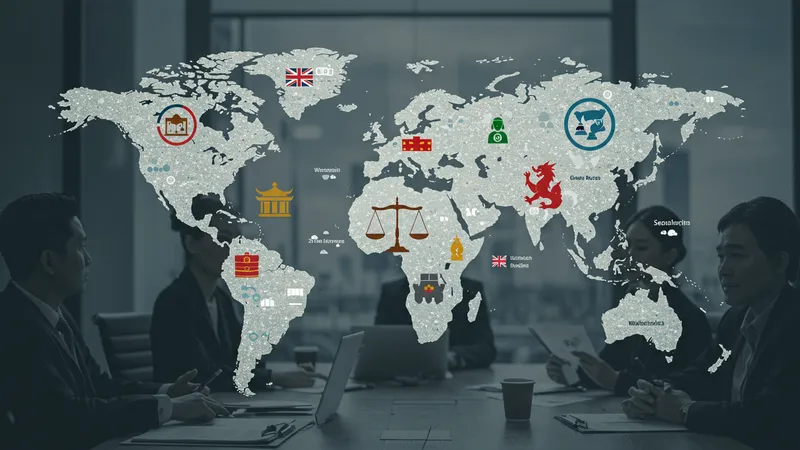Did you know that over 70% of businesses unknowingly breach employment laws every year? Ignorance isn't bliss when fines and lawsuits loom over your company's future.
As remote work redefines workforce dynamics, staying compliant is not just about ticking boxes—it's about keeping your company safe in an ever-evolving legal landscape. The risks have never been higher.

Imagine a world where your company is hit with a sudden, massive lawsuit because of an overlooked compliance issue. It happens more often than you'd think. The complexities of employment law can trip up even seasoned HR professionals. But that’s not even the wildest part—many employers don’t realize that outdated contracts can lead to costly litigation, and that’s not the half of it.
Most businesses focus on hiring and payroll, but there’s a hidden side to employment law that’s rarely discussed. Anti-discrimination policies are not just 'nice-to-have'; they are legally required and often misunderstood. Navigating these murky waters demands meticulous oversight—missteps can lead to enormous reputational damage. Still, there's an element to all these that remains under wraps, until now. What happens next shocked even the experts…
Many companies rush the hiring process, prioritizing filling vacancies over thorough vetting. This haste often results in ignoring compliance with stringent background check laws. The irony? This can lead to lawsuits or severe fines. Ensuring each step respects legal boundaries is crucial—but there’s one more twist that often gets overlooked: varying state laws can complicate even the most robust hiring systems. What you read next might change how you see this forever.

Background checks are more than just a cursory glance at criminal history; they encompass education verifications and even social media inspections. Each of these requires consent and documentation to ensure legal viability. Overstepping can cost companies millions in fines. But what's even trickier is knowing the exact timing and documentation required in different jurisdictions, making compliance a moving target.
Companies like Uber learned the hard way when settling millions for incorrect background checks, but they're not alone. Many fall into the trap of universal policies, not realizing the specific legal variations across state lines. Insider tip: employing a regional compliance specialist can save your firm a massive headache down the line, but how many actually do it?
The correct implementation of legal protocols is often hindered by fast-growth trends and lean staffing, causing compliance steps to slip through the cracks. Yet, as the business world adapts to rapid digital transitions, maintaining scrupulous record-keeping is paramount. The future of your company might just depend on these overlooked elements. But there’s a lesser-known shadow still looming.
Think your business is paying employees fairly? You might need to think again. Wage and hour laws are some of the most complex to navigate, and even minor oversights can lead to hefty penalties. What's more startling is the extent to which nuances in these laws can vary—not only internationally but also from state to state. But here’s the real kicker: certain exemptions apply that employers often overlook.

While overtime rules seem straightforward, they're anything but. Employees classified as salaried might not necessarily be exempt from overtime pay. Often, it’s the job duties, not the job titles, that define this status. Think of the potential impact if your payroll isn’t aligned with these requirements. The financial risks don’t stop there—incorrect calculations can lead directly to legal challenges from staff.
Moreover, break periods and meal laws are another minefield. Companies are often blindsided by strict mandates requiring employees to take uninterrupted breaks, sparking intricate legal conflicts if not enforced. The secret many don't know: adhering to both state and federal standards is not just mandatory but also a safeguard against future disputes.
Outsourcing payroll might seem like an easy solution, but even third-party services make errors that you are ultimately liable for. The smart move? Regular audits and updates to ensure you stay ahead of the curve. But that's just one chapter in this complex tale—there's more beneath the surface.
Here’s an alarming truth: over 65% of workplace discrimination goes unreported. It’s not just about protecting employees; it's a legal obligation to safeguard your company against lawsuits. But how many businesses fail at enforcing anti-discrimination policies comprehensively?

Unconscious bias training is a buzzword, yet few fathom its true legal importance. Not adequately addressing implicit bias can open the door to discrimination claims. Implementing policies isn't enough; employees and management must be trained and retrained regularly. But here's the shocking twist: many companies don't realize they need tailored training for different departments, leaving legal loopholes wide open.
Consider the case where a major retailer paid out millions in settlements because their anti-discrimination policies were not properly communicated or enforced. The takeaway? Transparency and consistent communication are key. Yet, another aspect slips through unnoticed: remote workers may require different oversight to ensure equity as digital platforms become the modern workplace.
The rise of hybrid and remote work environments adds layers of complexity to seemingly straightforward policies. Underestimating these nuances might cost you dearly. As you delve deeper, there's another facet of compliance that transforms everything you thought you knew.
In the digital age, data is currency, but it comes with its share of compliance hurdles. With regulations like GDPR and CCPA, data privacy is no optional endeavor—it’s a mandate. Yet, the field is strewn with hidden mines, unnoticed by many businesses.

Firms are regularly fined for breaches resulting from improper handling of employee data, which means diligently safeguarding this information is paramount. Misguided practices, such as storing unencrypted data or lacking proper access controls, put businesses at risk. The hidden gem many overlook: regular data audits can prevent massive breaches and penalties.
Tools like data encryption software and VPNs offer layers of protection, but they must be implemented correctly. Not every tool is one-size-fits-all; understanding the distinct requirements of various jurisdictions is a game-changer for organizations navigating global markets.
Managers don’t often see the direct connection between data compliance and everyday HR operations. The reality is, digital footprints left unchecked can intertwine with employment law, unearthing various non-compliance issues. The synergy here is undeniable, yet another corner of this compliance maze may surprise you.
For many, meticulous record-keeping seems like red tape, yet it is the backbone of compliance. Without it, proving adherence to employment law is nearly impossible. What might stun you is not just the necessity of records, but the exact method used to manage and organize them.

The ongoing digital transformation urges a shift from paper files to electronic records, yet few know the optimal practices for this transition. Integrating systems that keep track of every detail can save a company in case of audits, but more importantly, it streamlines accessibility, enhancing operational efficiency. Many overlook that cloud-based solutions offer real-time updates and improved security—but these come with their own set of challenges.
Consider the costly implications of poorly maintained records. Not only do they invite unwanted scrutiny and audits, but they can also crumble under the slightest legal scrutiny. It's here companies must understand the legal standards for both retention and disposal of HR records. A misstep here can unravel a compliance web built over years.
As businesses grow and merge, maintaining continuity in record-keeping becomes vital. Harmonizing old and new systems prevents gaps in compliance documentation. But there’s a less revealed truth about the cataloging process that could shift everything.
Training isn't just for onboarding—it’s a vital strategy for ensuring compliance. Yet, countless companies make the mistake of providing generic training. This surface-level engagement does little to arm employees with the real-world knowledge needed to navigate complex laws.

A shockingly low percentage of employees feel adequately informed about their own working rights, leading to potential unrest and legal repercussions that could easily be avoided with comprehensive modules. When training investments fail to cover specifics like harassment, data privacy, and workplace safety, companies set themselves up for failure. Yet, many are unaware of how often these lapses occur.
Think about the impact of legal simulations in training, which help employees experience and understand policy violations, thus minimizing risks. These interactive programs have been shown to drastically decrease workplace incidents, yet adoption remains sporadically low.
The need for continual education in the workplace is often underestimated. Ongoing workshops and seminars ensure that everyone remains up-to-date with legal requirements, supporting a culture of compliance that can pivot with rapid regulatory changes. However, there’s a layer of training integration often missed that could revolutionize employee engagement.
Misclassification of employees is a trap many companies fall into, whether through oversight or design. Labeling employees incorrectly as independent contractors can lead to staggering repercussions. And the real kicker? Some businesses don’t even acknowledge this as a risk until it’s too late.

Misclassification leads to a loss of workers’ rights and potential unpaid taxes. While auditors often fixate on this during inspections, it’s the businesses that suffer in the end with fines and damaged reputations. Knowing the difference between a contractor and an employee is no longer enough—the contextual legalities must be appreciated.
Using the wrong classification title can invite unannounced investigations from government bodies. Remember, these designations aren’t just about payroll—they affect benefits, protections, and even rights to organize. It’s a hidden issue surfacing unexpectedly during robust audits, causing more than fiscal distress.
The silver lining? A proper classification strategy, confirmed through regular reviews, not only ensures compliance but also fosters trust within the workforce. Yet, there’s a nuance within this process that can transform how businesses perceive employment standards altogether.
Compliance often feels like a box-ticking exercise, but culture is what truly embeds its principles. Transforming a company's ethos to prioritize compliance at every level turns adherence into a natural byproduct. Yet, what corporations often miss is how profoundly culture protects against ethical and legal lapses.

A compliance-centric culture encourages employees to be proactive about spotting and addressing non-compliance issues before they escalate. Having open lines of communication ensures minor violations are reported without fear of reprisal, fostering a sense of collective accountability. Businesses with such cultures see fewer social media disasters and find themselves navigating crises with ease.
This isn’t just a top-down mandate. It’s about integrating compliance through community-building events and shared values. Interactive forums and feedback loops, when treated with the same seriousness as bottom-line outcomes, shape robust compliance mindsets which become second nature over time.
While policies prepare companies for external challenges, aligning them with a strong cultural backbone shields them from within. There's a deeper reality about how company culture intersects with legal frameworks—revealing this truth could redefine workplace standards worldwide.
In an age where technology underpins every aspect of operation, its role in compliance is transforming faster than ever. AI-driven solutions provide dynamic monitoring and predictive insights, yet many businesses are slow to embrace these innovations. This hesitation might be more costly than ever imagined.

The beauty of technology lies not just in automation, but in its ability to analyze and preemptively identify compliance breaches. Wearable tech, for instance, monitors workplace safety in real-time, alerting HR to potential violations immediately. Still, despite such advances, adoption rates remain mystifyingly low, exposing companies to unnecessary risk.
The integration of compliance tech shouldn't feel like a leap—it's a natural evolution. Yet, tech investments must align with awareness training to harness full potential. Understanding its capabilities isn't widespread, as numerous firms still struggle to manage data flows and documentation, leaving them with fragmented compliance frameworks.
This digital revolution of compliance does more than protecting; it offers a competitive edge. Companies leveraging tech effectively prepare themselves for future regulations as they evolve. A hidden benefit reveals itself as you delve deeper into virtual landscapes—one that can redefine industry norms.
The path to global expansion is paved with the complexities of navigation varying employment laws. While expanding might seem alluring, it necessitates more than just entering a new market—it demands an intricate understanding of each country's compliance landscape. But here's the catch: many businesses underestimate the legal nuances.

Global compliance isn't just about knowing international laws but respecting cultural sensitivities. Failing to do so can harm global operations and brand perceptions. Identifying these cultural undercurrents early on can ensure seamless integration and mitigate legal snafus. There's often much more at play than meets the eye.
Regulation clashes emerge as businesses grapple with differing labor laws, often inadvertently overstepping due to ignorance or misinterpretation. Harmonizing diverse legal systems under a unified compliance strategy is a meticulous task that can protect investments in the long run.
Hiring local legal experts not only simplifies regulatory challenges but also enriches business strategies with localized insights. But an often-missed gem? Cultural adaptability might hold more sway over compliance success than rigid policy adherence—this overlooked truth might just change everything.
In a world where regulations are constantly evolving, the biggest mistake is to rest on compliance laurels. Employment law is a living entity, ever-changing and demanding proactive foresight. The real question remains—are you prepared for tomorrow's challenges?

Staying ahead means embracing continuous education, regular policy reviews, and engaging in compliance think tanks. It's this investment in foresight that sets trailblazers apart from laggards. But here's a critical insight: those who innovate in their compliance approach tend to navigate legal storms with greater resilience.
Technological foresight should blend with workforce training, preparing employees for shifts in legal machinery. You've dealt with the 'now,' but are you thinking about what's next? The organizations that do not merely survive but thrive are those that view compliance as a strategic advantage.
Aligning compliance goals with business growth strategies is not an ‘extra’—it's necessary for modernization. As laws evolve, so too must the measures you put in place to respect them. What happens when the flexibility to adapt becomes a decisive factor in staying compliant? It’s a revelation many are unprepared for.
The ultimate takeaway is simple, yet profound. Compliance isn't just a procedural necessity but a vital part of strategic business survival. As laws evolve and stories like yours unfold, staying informed and agile is key to thriving—not just surviving. Remember, compliance could be the make-or-break factor in today’s zealous regulatory environment.
Engage with this story, share it widely, and ensure everyone in your sphere is prepared for the ever-shifting sands of employment law. The dialogue doesn’t just stop here—it's a call to action for tomorrow's legion of compliant-oriented thinkers and doers. Bookmark this journey to compliance wisdom, for it might just be your company's saving grace.